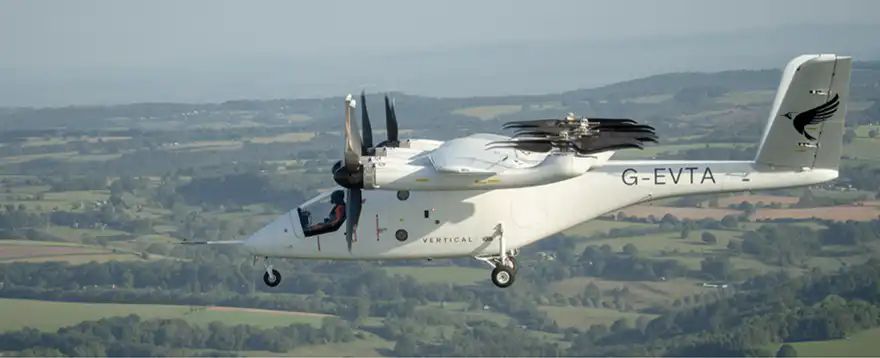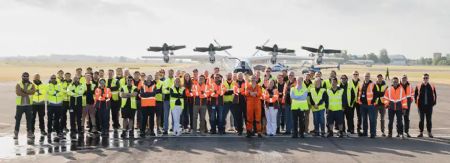 Vertical Aerospace
Vertical Aerospace (Vertical), a global aerospace and technology company that is pioneering electric aviation, last month made European aviation history with the first-ever piloted wingborne flight of a winged electric vertical take-off and landing (eVTOL) aircraft in open airspace.
The landmark flight of the VX4 prototype, piloted by chief test pilot Si Davies, saw the aircraft take-off, fly and land like a conventional aircraft, with lift generated by the wing. Soaring across the UK countryside from Cotswold Airport, the VX4 prototype demonstrated controlled wingborne flight in open airspace for the first time, marking a critical step toward commercial deployment as part of Vertical’s Flightpath 2030 strategy.
The UK Civil Aviation Authority (CAA) approved the flight through open airspace at Cotswold Airport, the UK’s largest private airport, by extending Vertical’s Permit to Fly. This followed a rigorous review of tens of thousands of pages of safety and technical documentation.
Mr Davies said: “Taking the aircraft beyond the airfield and cruising over the Cotswolds for the first time was truly special and a career highlight for me. Our performance predictions were absolutely spot on, and the aircraft took off as a natural extension of all the ground tests and preparation we have done.
“There are aircraft which are safe and capable but not always enjoyable to fly. The VX4 was not only safe but was an absolute pleasure. It is responsive, smooth, simple to operate and the sound level from the propellers is quiet and pleasant in the cockpit. An honour to fly, and a real testament to the incredible team behind it.”
Vertical Aerospace is currently the only company globally flying a piloted winged eVTOL prototype that has been developed under a Design Organisation Approval (DOA) from the CAA — a DOA is required to hold a Type Certificate, required for commercial passenger operations. The CAA is working closely with the European Union Aviation Safety Agency (EASA) for their concurrent validation and certifying the VX4 to the highest safety standards required for commercial use.
Important moment in the certification journeyVertical Aerospace’s CEO Stuart Simpson said: “Achieving piloted wingborne flight in open airspace under the oversight of the UK CAA is an important moment in our certification journey. Operating under the UK’s rigorous regulatory framework means we share the burden of safety with our regulator — every step must be approved, and that is by design. It amounts to a mini certification of our prototype and gives us a clearer, faster path to type certification.
“Our decision to put a pilot into the VX4 early was deliberate — real-world piloted flight delivers insights no simulation can. This milestone proves the capability of the aircraft and the maturity of our programme as we move toward commercial operations.”
This achievement has also been supported by early UK Government investment through programmes
including the Aerospace Technology Institute and the Future Flight Challenge. These initiatives have
contributed to the development of Vertical’s technology and flight test campaign, and form part of wider efforts to advance the UK’s ‘net zero’ and aerospace ambitions.
 Pictured right: the Vertical team, including Si Davies, the chief test pilot, following the latest piloted flight test milestone
Pictured right: the Vertical team, including Si Davies, the chief test pilot, following the latest piloted flight test milestoneJonathan Reynolds, UK Secretary of State for Business and Trade, said: “This is a fantastic milestone for Vertical Aerospace and for the UK’s world-class aerospace sector. Breakthroughs like this show how the Government and business can work together to keep the UK at the cutting edge of innovation. Our modern industrial strategy will double down on this success by giving investors the confidence they need to back UK advanced manufacturing for the long term, bringing good, ‘green’ jobs and growth across the UK.”
In Phase 3 of testing — wingborne flight — the VX4 operates like a conventional aircraft using lift generated by its wings, rather than relying solely on rotor thrust. This low-power, quiet, and range-efficient mode of flight is key to making electric air travel practical, scalable, and economically viable.
Key roleHoneywell Aerospace Technologies’s president and CEO Jim Currier said: “This significant achievement underscores the ability of our partnership to unlock new and innovative modes of transport, and we are proud
Honeywell Anthem avionics and flight control computers and software could play a key role in supporting such a defining moment for the industry.”
David Stepanek, Bristow Group’s EVP & CTO said: “The VX4’s successful demonstration of wingborne flight marks a significant step towards commercial readiness. As a global leader in innovative and sustainable vertical lift, we look forward to continuing to partner with Vertical Aerospace to unleash the disruptive advantages of this aircraft.”
Jill Blickstein, vice president of sustainability at American Airlines, said: ”This milestone is a key step toward safely scaling electric aviation, which we believe will play a key role in the future of our industry. We are proud of Vertical Aerospace’s progress toward sustainable travel.”
By achieving stable and controlled wingborne flight, Vertical Aerospace has taken a significant step toward the next major milestone — a full piloted transition flight, expected in the second half of 2025. This will demonstrate the VX4’s ability to shift seamlessly between vertical lift and forward cruise — the operating mode it will use in passenger service.
During the wingborne flight phase, the VX4 will reach speeds of up to 150mph and altitudes
close to 2,000ft under real-world conditions. Engineers captured more than 30,000 in-flight data
parameters, confirming the aircraft performed exceptionally across stability, control, and energy usage.
To prepare for piloted wingborne flights, Vertical Aerospace completed thousands of hours of lab simulation, and high speed ground testing, including: 7.2 million fatigue cycles on each propeller blade to simulate lifespan loads over the flight test campaign; 15.2m battery pack drop test, comparable to fuel-tank testing in traditional rotorcraft; full-scale thermal runaway propagation test on a VX4 sub-pack, indicating safe flight and landing is possible even in the event of a battery fire; and over 3,000 hours of component and integration testing on flight control computers to ensure system reliability and performance.